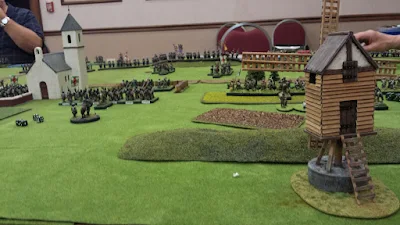Time to get my Crimean War collection out! Here is a past game night battle I never recorded. The battle on McKenzie Heights saw a Russian division of 12 infantry battalions, four batteries and three cavalry regiments defending a cross roads. Fortifications have been added to add strength. Meanwhile two British divisions advance to capture the same cross roads. Rules used were Charge of the Light Brigade, and all figures were 25mm from Wargames Foundry and North Star miniatures.
The Russian commanders placed all four batteries behind fortifications along the front line. Four battalions defended the tiwn, and four more battalions were placed on each flank. Two cavalry regiments guard the Russian right flank while one cavalry regiment guard the left flank.
The rules are a U-Go-U-Go but with a twist. Each regiment gets so many command points. These can be used to do addition actions. When it is your turn each unit can do one free action (move, fure, change formation, lumber or unlimber). After The free action they can spend a command point and do a second action. They can do a third action which cost two command points. And so on. But once spent command points are gone. Better units have more command points, poorer have less. When you spend a command point The other sides gets to react to it by returning fire. Intetesting! You can get morale chips for being under fure, or losing a close combat. For each moral marker you get you subtract one pip from every die roll. So this quickly becomes dangerous.
The Game:
The British placed the 1st Division (Guards and Highlander) on their right with orders to outrank the village. The Light Division crossed a minor stream to attack the village in front and hold most of the Russia's attention. The Light Cavalry brigade was held off table.
On the Russian Right Flank:
 |
| Supported by a battery two Russian battalions advance against the British line. |
As the British came into the board and crossed the stream, the Russian commander launched an attack. Two infantry battalions and a Hussar and Cossacks regiment charged the British line. During his move the Russian commander spent an extra command point to move his forces more quickly forward. But he was hampered by poor dice rolling (movement is by five roll and he rolled very low).
The British commander not believing his good luck spent a command point and got his artillery into line and unlimbered, while his infantry fired twice at the Russians causing high casualties.
When the charges went in they were easily defeated and sent routing back with high casualties and multiple morale markers. The Russian commander then advanced two more infantry battalions, this time in line to exchange fire with the British. Superior rifles and numbers told and the decimated Russian infantry retired. The British proceeded to silence the batteries with long range rifle fire.
Russian Left Flank:
The British 1st Division advanced into range to engage the Russians with rifle fire. Good die rolling from the Russians saw the British battery silenced very quickly. The Russians used a number of command points to change formation from double line into line to bring more muskets against the British. This did not work.
In a desperate effort to stop the British the Russian commander charged the nearest enemy with his cavalry regiment. Ironically, that was the 93rd Highlander of the thin red line fame. This time history did not repeat itself and the cavalry win the close combat. The retreating highlander caused disorder as they retired and the Russian cavalry charged into the next unit the 42nd. This time, supported by the Guards the Russian cavalry broke and retired off the board. With little opposition in front of them the British continued their advance.
At this point the game was called. Both flanks were wide open and two batteries silenced .So the Russians had little chance of stopping the British.
The game was fast paced and great fun. All agreed that the rules were easy to understand and provided interesting twists with the command points. one point were All agree on was in future battles more Russian infantry needs to be on the table to counter British superior rifle range. All are interested in playing again soon.




























